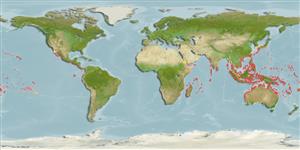Actinopterygii (ray-finned fishes) >
Anguilliformes (Eels and morays) >
Ophichthidae (Snake eels) > Ophichthinae
Etymology: Pisodonophis: Greek, piso, pipisko = to drink + Greek, odous = teeth + Greek, ophis = serpent .
Environment / Climate / Range
Ecology
Marine; freshwater; brackish; reef-associated; anadromous (Ref. 51243); depth range 1 - 20 m (Ref. 90102). Tropical, preferred ?
Indo-Pacific: Red Sea and East Africa to French Polynesia, north to the Ogasawara Islands, south to Australia.
Size / Weight / Age
Maturity: Lm ? range ? - ? cm
Max length : 108 cm TL male/unsexed; (Ref. 1479); common length : 50.0 cm TL male/unsexed; (Ref. 7245)
Dorsal
spines
(total): 0;
Anal
spines: 0;
Vertebrae: 152 - 163. Teeth molariform, multiserial on jaws, intermaxillary and vomer; dorsal fin with broad dark edge (Ref. 37816). Dorsal fin beginning above pectoral fin (Ref. 12693). Body snake-like, cylindrical, compressed only along extreme tail tip; anterior nostril tubular, posterior nostril along lower edge of lip; median fins not continuous posteriorly; extreme tip of tail stiff and finless; dorsal fin origin over front to middle portion of pectoral fins; lateral line inconspicuous (Ref. 4832). Variable from grey to black or brown. Large individuals have wrinkled skin (Ref. 48635).
Occurs in lagoons and estuaries, entering freshwater (Ref. 12693). Often in tidal channels where loose groups congregate, and usually seen with just the head exposed (Ref. 48635). Caught most often in tidal areas and estuaries (Ref. 12693). Caught in bag nets and similar gear. Marketed fresh (Ref. 7050).
Life cycle and mating behavior
Maturity | Reproduction | Spawning | Eggs | Fecundity | Larvae
McCosker, J.E. and P.H.J. Castle, 1986. Ophichthidae. p. 176-186. In M.M. Smith and P.C. Heemstra (eds.) Smiths' sea fishes. Springer-Verlag, Berlin. (Ref. 3972)
IUCN Red List Status (Ref. 115185)
CITES (Ref. 94142)
Not Evaluated
Threat to humans
Harmless
Human uses
Fisheries: minor commercial
More information
Common namesSynonymsMetabolismPredatorsEcotoxicologyReproductionMaturitySpawningFecundityEggsEgg development
ReferencesAquacultureAquaculture profileStrainsGeneticsAllele frequenciesHeritabilityDiseasesProcessingMass conversion
Tools
Special reports
Download XML
Internet sources
